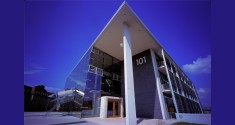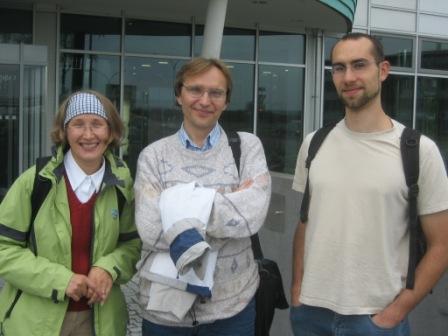Freiburg University 2006
From 2006.igem.org
Kouznetsov (Talk | contribs) |
|||
| Line 1: | Line 1: | ||
| - | [[Image:uf101.jpg]] | + | <center>'''Welcome! We are Alife Mutants.'''</center> |
| + | <p> | ||
| + | |||
| + | <center>[[Image:uf101.jpg]]</center> | ||
| + | |||
This term was invented by Martin Schneider on the Rule 110 Winter Workshop in 2004 [http://www.rule110.org/amhso/index.html]. We play without rules. We discover the rules that govern life, the universe and everything to exploit these rules and to create Artificial Life. Our short-time aim is the trip to Boston in November 2006 to take a prize in the iGEM. | This term was invented by Martin Schneider on the Rule 110 Winter Workshop in 2004 [http://www.rule110.org/amhso/index.html]. We play without rules. We discover the rules that govern life, the universe and everything to exploit these rules and to create Artificial Life. Our short-time aim is the trip to Boston in November 2006 to take a prize in the iGEM. | ||
| + | |||
| + | <center>[[Image:Freiburg_Team_06.JPG]]</center> | ||
| + | |||
| + | The Freiburg Team (well, at least half of it...) from left to right: Irina Petrova, Andrei Kouznetsov, Daniel Hautzinger. | ||
| + | |||
| + | |||
| + | == The Team == | ||
| + | |||
| + | Students: | ||
| + | *[[User:Daniel_Hautzinger|Daniel Hautzinger]] | ||
| + | *[[User:Marc_Wilnauer|Marc Wilnauer]] | ||
| + | *[[User:Olga_Soboleva|Olga Soboleva]] | ||
| + | *[[User:Irina_Petrova|Irina Petrova]] | ||
| + | *[[User:Tim_Barrel|Tim Barrel]] | ||
| + | *[[User:Mona_Klein|Mona Klein]] | ||
| + | |||
| + | iGEM instructor: | ||
| + | *[[User:Andrei_Kouznetsov|Andrei Kouznetsov]] | ||
| + | |||
| + | Faculty/staff: | ||
| + | *[[User:Svetlana_Santer|Svetlana Santer]] | ||
| + | |||
| + | == The project: DNA Folding== | ||
| + | |||
| + | ===Basic Idea:=== | ||
| + | |||
| + | ====Abstract==== | ||
| + | |||
| + | The idea is to design a strand of DNA such that it wraps into some meaningful shape. There are three different stages for this project: First, the DNA should fold into a twodimensional rectangular sheet. Secondly, this sheet should wrap itself up into the shape of a short tube. And last, these little tubes should hook themselves up to each other such that they form one single long tube. | ||
| + | |||
| + | ====Scetches==== | ||
| + | |||
| + | Insert pictures here | ||
| + | |||
| + | ===Application: Barbie Nanoatelier=== | ||
| + | |||
| + | Once the process of DNA folding into 3D-structures is understood, shapes can be chosen arbitrarily. The idea of the Barbie Nanoatelier is that the DNA should wrap into a 3D-TShirt, 3D-Pants, etc. | ||
== GEM Freiburg == | == GEM Freiburg == | ||
| Line 94: | Line 135: | ||
An Analysis of Synthetic Biology Research in Europe and North America [http://www2.spi.pt/synbiology/] | An Analysis of Synthetic Biology Research in Europe and North America [http://www2.spi.pt/synbiology/] | ||
DNA synthesis: ATG-Biosynthetics [http://www.atg-biosynthetics.com/] | DNA synthesis: ATG-Biosynthetics [http://www.atg-biosynthetics.com/] | ||
| + | '''Bold text''' | ||
Revision as of 20:23, 28 August 2006

This term was invented by Martin Schneider on the Rule 110 Winter Workshop in 2004 [http://www.rule110.org/amhso/index.html]. We play without rules. We discover the rules that govern life, the universe and everything to exploit these rules and to create Artificial Life. Our short-time aim is the trip to Boston in November 2006 to take a prize in the iGEM.

The Freiburg Team (well, at least half of it...) from left to right: Irina Petrova, Andrei Kouznetsov, Daniel Hautzinger.
Contents |
The Team
Students:
iGEM instructor:
Faculty/staff:
The project: DNA Folding
Basic Idea:
Abstract
The idea is to design a strand of DNA such that it wraps into some meaningful shape. There are three different stages for this project: First, the DNA should fold into a twodimensional rectangular sheet. Secondly, this sheet should wrap itself up into the shape of a short tube. And last, these little tubes should hook themselves up to each other such that they form one single long tube.
Scetches
Insert pictures here
Application: Barbie Nanoatelier
Once the process of DNA folding into 3D-structures is understood, shapes can be chosen arbitrarily. The idea of the Barbie Nanoatelier is that the DNA should wrap into a 3D-TShirt, 3D-Pants, etc.
GEM Freiburg
Club
- [http://omnibus.uni-freiburg.de/~kouznet/iGEM.htm Manifesto, Self-education program]
- [http://omnibus.uni-freiburg.de/~kouznet/Fellow06.htm GEM Freiburg Fellow 2006]
- [http://omnibus.uni-freiburg.de/~kouznet/GEMnews.htm News]
SB Preliminary
- DNA plug-and-play platform [http://omnibus.uni-freiburg.de/~kouznet/DNAplatform6.pdf 24.05.06] [http://omnibus.uni-freiburg.de/~kouznet/DNAplatform6-1.pdf 27.06.06]
- [http://omnibus.uni-freiburg.de/~kouznet/BioVLSI.pdf Very Large-Scale Integration design in Biology]
- [http://omnibus.uni-freiburg.de/~kouznet/GS-design.pdf Genetic systems design from the DNA modules]
Project
- [http://omnibus.uni-freiburg.de/~kouznet/life6000.pdf Life with a price of 6000 €]
Now we see it could be cheaper, but it will need a great intellectual impact. So, we’re opened for sponsors and relationships.
Comments
As I understand it, the idea is to create a "life automaton" consisting of 6 proteins? That is what I took out of your proposal. That seems quite ambitioned, but I can't really judge it, and even if it is quite ambitioned, that does not mean that it is bad, of course.
My understanding says that you are using 6000 € for denovo synthesis of 6 genes required for making minimal life. Right?
So, what if after all the simulations and tests on the computer, you order the DNA for minimal life and it turns out that it doesn't work... What will you do then?
This is because biology is unpredictable and you must not assume that the DNA which you order will work in the first time itself... You must keep some backup money or plans...
You have to separate specifically the general and specific objectives to long and short time; implications, obstacles and limitations.
OK, fine.. So you want to go in a completely different direction by creating alternative life.. Good.. All the best for this project.
Well, if you want to go to the extremes then are you limiting yourself to already established phenomena such as DNA, membranes, etc. You may want to adopt a completely new and novel ideas which might be simpler than DNA and other stuff of the normal cell.
So, keep all the options open. Research the literature well and create Artificial Life...
Questions
- - Dilettante: "Where is a place of synthetic biology here - good old gene engineering > bio-nanotechnology > orthogonal life > artificial life > artificial intelligence?"
- Expert: "Hmmm..." - - Professor: "What is new in Synthetic Biology?"
- Student: "Wiki!!!" - People on a street:
- "What is a synthetic biology - science or technology?"
- "Expedition." - - Shrödinger: “What is life?”
- Alice: “It’s a play where rules are constantly changed.”
Hey Mutant, have a look!
The easy and serious way
- [http://www.edge.org/documents/archive/edge187.html#church George Church CONSTRUCTIVE BIOLOGY] - a nice paper about the challenges of modern biology
- [http://webcast.berkeley.edu/events/details.php?webcastid=15766 The webcast from SB2.0]
These people do great things
Albert Libchaber [http://www.rockefeller.edu/research/abstract.php?id=93]
Carlos Bustamante's lab [http://alice.berkeley.edu/]
David Deamer [http://www.chemistry.ucsc.edu/deamer_d.html]
Eric Kool’s group [http://www.stanford.edu/group/kool/]
Erik Winfree [http://www.dna.caltech.edu/~winfree/]
Fred Menger’s group [http://www.chemistry.emory.edu/faculty/menger/index.html]
Jack Szostak’s lab [http://genetics.mgh.harvard.edu/szostakweb/]
Norman Packard’s Protolife [http://www.protolife.net/]
Pier Luigi Luisi’s group [http://www.plluisi.org/index.html]
Radhika Nagpal [http://www.eecs.harvard.edu/~rad/]
Steven Benner’s group [http://www.chem.ufl.edu/groups/benner/]
Local
An Analysis of Synthetic Biology Research in Europe and North America [http://www2.spi.pt/synbiology/] DNA synthesis: ATG-Biosynthetics [http://www.atg-biosynthetics.com/]
Bold text